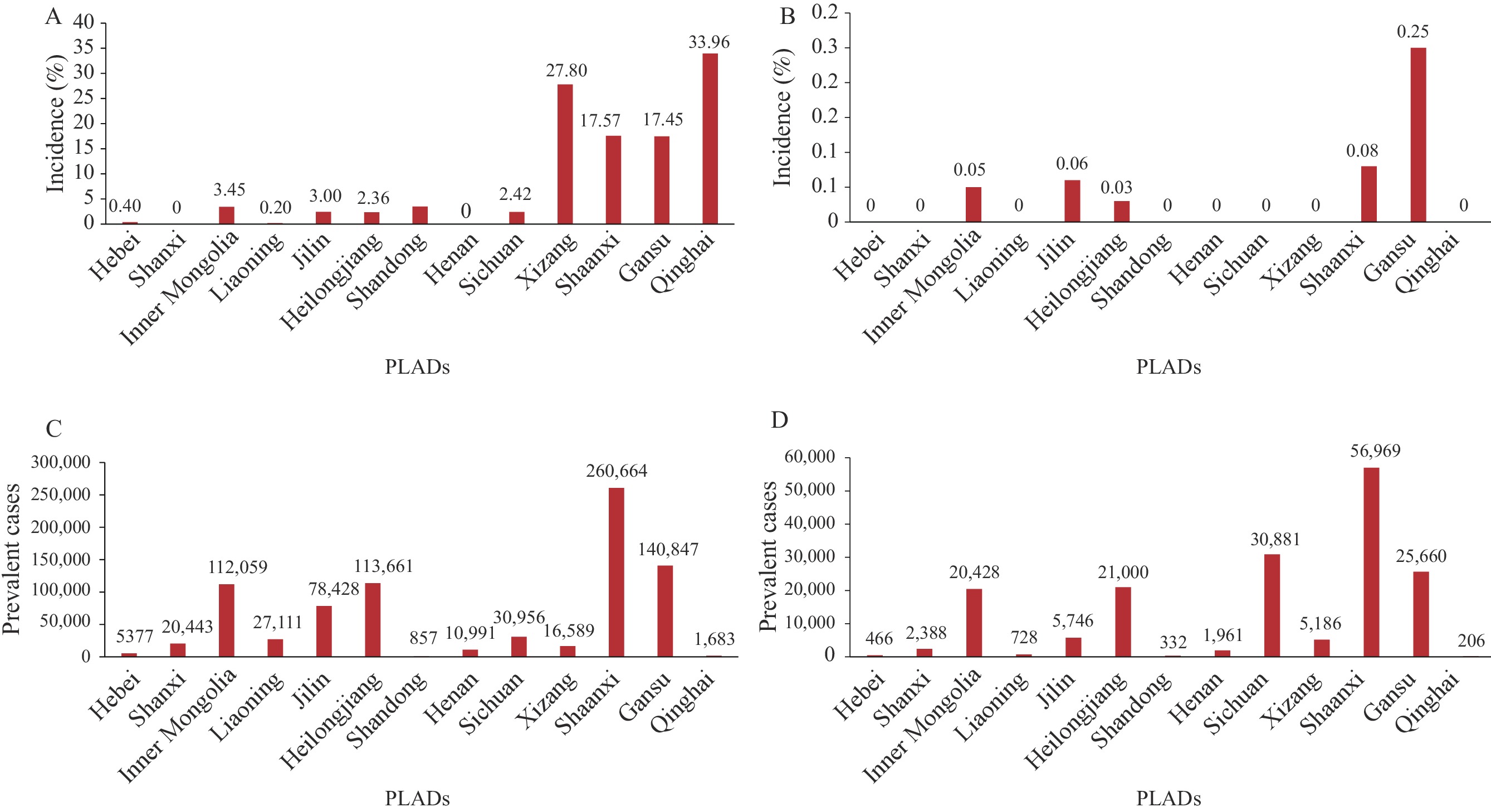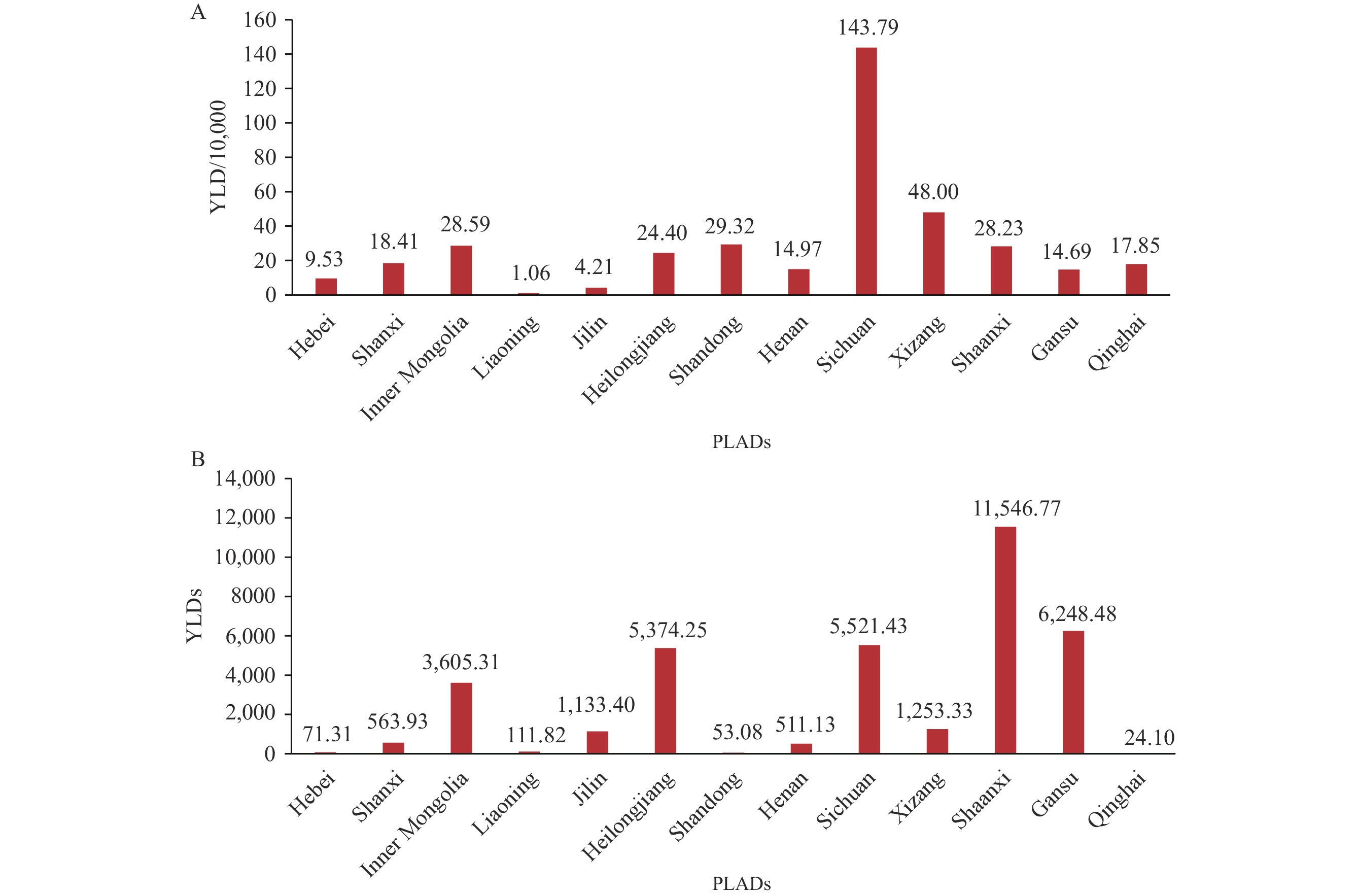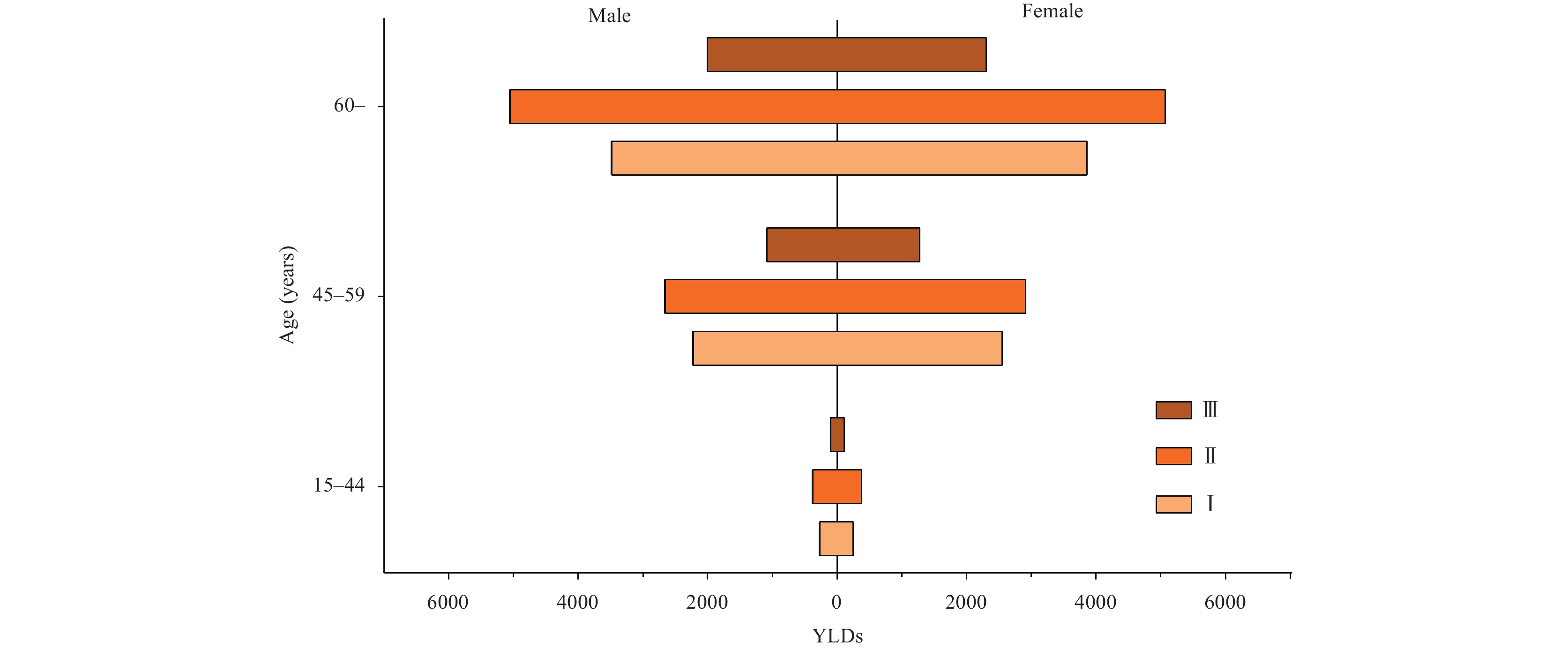-
Kashin-Beck disease (KBD) is a chronic, endemic osteoarthritic disease that primarily affects children and adolescents. Its etiology remains uncertain. Mild cases of KBD result in thickening of bones and joints, while severe cases lead to joint deformity and permanent disability (1–2).
During the 1960s and 1980s, KBD became highly prevalent in China, with X-ray detection rates of 70% to 80% in the most affected areas (3). Thanks to decades of prevention and control efforts, the disease’s prevalence in the country has significantly decreased, and no new cases have been reported among children. However, there are still over 170,000 existing KBD patients (4).
The objective of this paper is to assess the disease burden and economic impact of KBD in China for the year 2021, focusing on government perspectives. This information will serve as a guideline for formulating and enhancing prevention and control strategies.
The data for this study was obtained from the national surveillance system for KBD and the 2021 national case survey of patients with current endemic disease status. The surveillance data from 2002 to 2021 included information on the incidence and prevalence of KBD in 13 provincial-level administrative divisions (PLADs, including Hebei, Shanxi, Inner Mongolia, Liaoning, Jilin, Heilongjiang, Shandong, Henan, Sichuan, Xizang, Shaanxi, Gansu, and Qinghai). The 2021 national case survey collected basic demographic information on KBD severity, age, gender, and place of residence. The population base for this study was determined by the number of permanent residents in villages located in the endemic disease area.
Since KBD does not typically result in immediate fatality but instead causes long-term disability that significantly impacts the patient’s quality of life, this research paper aims to evaluate the health consequences of KBD by quantifying the years lived with disability (YLDs). For this analysis, we calculated the prevalence-based YLDs, as outlined in previous studies (5). The formula used for this calculation is provided below:
$$ YLDs =P \times DW $$ The variable P represents the number of individuals affected by KBD. DW is a weighting factor that reflects the severity of the disease, ranging from 0 (indicating a healthy individual) to 1 (indicating a deceased individual) (6). The clinical characteristics of KBD are similar to other musculoskeletal disorders mentioned in the Global Burden of Disease (GBD) 2019 study. Therefore, the disability weights for KBD were directly adopted from the weights assigned to other musculoskeletal disorders in the GBD, which were 0.117 (degree I), 0.317 (degree II) and 0.581 (degree III).
The indirect economic burden is determined by combining YLDs and the human capital method (HM), using the following formula:
Indirect economic burden = national per capita income in the endemic disease area villages × YLDs × productivity weights.
According to Murray’s criteria (7), different productivity weights were assigned to different age groups. For children aged 0–14 years who are not yet participating in the social workforce, the productivity weight coefficient was set at 0. The values for age groups 15–44, 45–59, and 60 years and over were set at 0.75, 0.80, and 0.10, respectively. Data on per capita income in endemic villages in each PLAD were obtained from the 2021 National KBD Surveillance Report.
In 2002, there were marked regional variations in the prevalence of KBD, specifically higher rates of positive X-ray findings in children from the western region, including Qinghai (33.96%) and Xizang (27.8%). Due to the implementation of rigorous national preventive and control measures, the incidence of KBD was effectively controlled by 2018, with the prevalence rate in all PLADs approaching 0 (Figure 1A, B). Moreover, no new cases of KBD were reported among children in affected villages nationwide in 2019, within the timeframe of the “Special Three-Year Action Program for Endemic Disease Control (2018–2020)” (8). From 2002 to 2021, the number of affected individuals decreased from 819,666 to 171,951, although the number of cases in Inner Mongolia, Heilongjiang, Sichuan, Shaanxi, and Gansu PLADs remains above 20,000 (Figure 1C, D).
 Figure 1.
Figure 1.Incidence and prevalence of KBD disease by PLAD in China. (A)The incidence of KBD disease by PLAD in China in 2002; (B) The incidence by PLAD in China in 2018; (C) The number of KBD disease patients by PLAD in China in 2002; (D) The number of disease patients by PLAD in China in 2021.
Abbreviation: PLAD=provincial-level administrative division; KBD=Kashin-Beck disease.This study revealed the YLD rates and YLDs in China to be 21.24 YLD/10,000 and 36,018.33 YLDs, respectively. Figure 2 illustrates the spatial distribution of KBD healthy life loss by PLAD, with the most severe areas of healthy life loss concentrated in the western region and Heilongjiang Province. Sichuan (143.79 YLD/10,000, 5,521.43 YLDs) and Xizang (48.00 YLD/10,000, 1,253.33 YLDs) had YLD rates exceeding 30 YLD/10,000 people (Figure 2).
 Figure 2.
Figure 2.YLD rate (A) and YLDs (B) for KBD by PLAD in China, 2021.
Abbreviation: YLDs=years lived with disability; KBD=Kashin-Beck disease; PLAD=provincial-level administrative division.Based on Murray’s criteria for assigning productivity weights to different age groups, this study classified KBD patients into three age groups: 15–44, 45–59, and 60 years and above, which accounted for 4.21%, 36.36%, and 59.43% of the total patients, respectively. Among all patients, 62.88%, 30.21%, and 6.91% were categorized as having first, second, and third degree severity respectively.
The results presented in Figure 3 demonstrate a significant increase in YLDs with advancing age (P<0.05). Notably, patients with degree II severity and those aged 60 years and above accounted for the largest proportions, with approximately 16,468 and 21,794 YLDs respectively. Additionally, no statistically significant difference in YLDs by gender was observed across all age categories (P>0.05).
 Figure 3.
Figure 3.Age-sex-specific YLDs among KBD grades in China, 2021.
Abbreviations: YLDs=years lived with disability; KBD=Kashin-Beck disease.According to Table 1, a total of 171,951 patients diagnosed with KBD were included in this analysis of indirect economic costs. The indirect economic burden of KBD in China in 2021 was estimated to be 112.74 million Chinese Yuan (CNY), equivalent to 655.63 CNY per capita per year. PLADs with particularly high indirect economic burdens include Inner Mongolia (18.59 million CNY, 16.49%), Heilongjiang (20.31 million CNY, 18.02%), Sichuan (19.38 million CNY, 17.19%), Shaanxi (32.82 million CNY, 29.11%), and Gansu (14.28 million CNY, 12.67%) (Table 1).
PLAD Indirect economic burden (10,000 CNY) Age group (years) Total 15–44 45–59 60 and above Hebei 0.24 4.82 2.59 7.65 (0.07%) Shanxi 0.62 37.60 26.35 64.57 (0.57%) Inner Mongolia 115.82 1646.50 96.80 1859.13 (16.49%) Liaoning 0.00 9.36 14.16 23.52 (0.21%) Jilin 7.78 185.69 93.31 286.78 (2.54%) Heilongjiang 51.65 1709.27 270.12 2031.04 (18.02%) Shandong 0.24 8.43 4.34 13.02 (0.12%) Henan 1.86 57.16 18.45 77.46 (0.69%) Sichuan 383.19 1175.41 379.69 1938.29 (17.19%) Xizang 130.25 108.99 13.13 252.37 (2.24%) Shaanxi 71.46 2448.08 762.12 3281.66 (29.11%) Gansu 61.23 1157.37 209.82 1428.43 (12.67%) Qinghai 2.10 6.79 0.86 9.74 (0.09%) Total 826.43 8555.47 1891.75 11273.65 Abbreviation: KBD=Kashin-Beck disease; PLAD=provincial-level administrative division; CNY=Chinese Yuan. Table 1. Indirect economic burden of KBD by PLAD in China, 2021.
-
This study utilized the YLD indicator to estimate the reduction in healthy life expectancy caused by KBD across 13 Chinese PLADs in 2021. Furthermore, for the first time, the YLD indicator was combined with the human capital approach to calculate the indirect economic burden. This integrated approach allows for a more comprehensive assessment of the impact of KBD on both health and the economy.
The findings of this study revealed that despite China’s implementation of various preventive and control measures resulting in zero reported cases of KBD in recent years, there still exists a population of 171,951 patients. The spatial distribution of KBD’s impact on healthy life expectancy by PLAD in 2021 identified the western region (Gansu, Sichuan, Inner Mongolia, and Shaanxi) and the eastern region PLAD (Heilongjiang) as experiencing the most pronounced loss in healthy life expectancy. Analysis of the age and gender distribution of healthy life span loss indicated significant discrepancies in YLDs across different age groups (P<0.05), with the highest YLDs in the age group of 60 years and over, followed by those aged 45–59 years. Notably, there were no statistically significant gender disparities in YLDs across different disease levels (P>0.05), consistent with a previous study conducted in Bin County, Shaanxi Province (9).
The total indirect economic burden in 2021 amounted to 112.74 million CNY, with a per capita burden of 655.63 CNY per year. Inner Mongolia, Heilongjiang, Sichuan, Shaanxi, and Gansu PLADs experienced particularly high levels of indirect economic burden. The impact of patients’ labor loss and reduced productivity on indirect losses is substantial.
This study has two limitations. First, there is a lack of accepted studies providing disease weights specifically for KBD. Hence, we utilized the disability weights for other musculoskeletal disorders from the GBD 2019 as a suitable reference in our study (10). Second, the economic burden analysis in this study did not take into account the direct economic burden and intangible economic burdens associated with KBD. As a result, the estimated economic burden of KBD may be underestimated.
In conclusion, while efforts have been made to control the current KBD epidemic, the disease and economic burden it poses are still substantial. Our study revealed that KBD was particularly severe in the western PLADs of China, with Sichuan Province having the highest YLD rate. The greatest proportion of YLDs occurred in patients with degree II of severity and individuals aged 60 and above. Shaanxi Province experienced the most severe indirect economic burden, with losses exceeding 30 million CNY. Gender did not significantly influence disease burden, but age was a crucial factor. These findings will aid the government in developing targeted prevention and control measures, as well as providing appropriate healthcare and financial assistance to areas affected by KBD. This will ultimately enhance the quality of life and economic well-being of patients.
-
No conflicts of interest.
HTML
| Citation: |




 Download:
Download:





